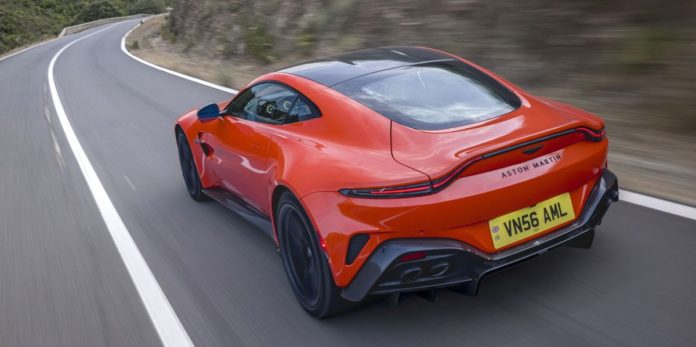The corny tagline at the media launch in southern Spain for the new Aston Martin Vantage was “engineered for real drivers.” As cliché as it sounds, it can be said with a straight face. This is a departure from past Aston sports cars, when such a claim might have been called an overreach. Yes, they would lap a racetrack just fine. Yes, they would be fun. But not this much fun, and certainly not this lively and competent.
Aston says the understeer gradient is 12 percent less than before, but that might as well be an alien language to most. In the King’s English, it means the chassis is more neutral. In terms of feel and control, it means you can steer it with the wheel, the brakes, or even the throttle if you don’t mind eating through the 21-inch Michelin Pilot Sport 5S tires developed for the Vantage, similar to those created for the newly launched DB12.
In street driving, there’s no need to get into the Vantage’s nine-position traction-control adjustment. It functions similarly to other multiposition traction systems that give the driver a progressive amount of slip-angle leeway, among other parameters. Traction is ample, and any assist on the street is so seamless that we never felt the need to turn off ESC entirely.
A chat with Simon Newton, Aston’s director of vehicle performance, makes clear that the company is chasing a mindset more than a lap time. The bonded-aluminum chassis is largely carryover, but the tweaks to stiffness are felt and even seen: A transverse tube spans the trunk area that ties the rear corners together. It’s one of the many subtle changes to improve feel and feedback.
There are no air springs, no active anti-roll bars, no rear-wheel steering, no magic that can hide deficits and mask excessive mass. Even the brake booster is a vacuum unit that contributes to one of the most honest pedals of recent memory. No fake by-wire nonsense here. Yes, there are some electronic aids, but overall, the Vantage’s setup is one we only hope spreads to other automakers.
It certainly helps that Aston’s Mercedes-based 656-hp V-8 produces some serious zip. This is a massive 153-pony increase over the outgoing Vantage. It gets there with the help of revised heads and camshafts, as well as larger turbos. Despite the snails’ bigger impellers and turbine wheels, lag is all but nonexistent. It feels like power builds more naturally than the torque plateau of 590 lb-ft between 2750 and 6000 rpm suggests. Aston Martin claims the engine will propel the new Vantage to 60 mph in 3.4 seconds, but that’s undoubtedly conservative. The quicker of two previous Vantages we tested did the deed in 3.4, and it made only 503 horsepower and weighed about the same, just a bit under 3750 pounds. When we get a Vantage to test, we wouldn’t be shocked if this performance metric started with a two instead.
Carving a lucrative piece of the premium-luxury-sports-car pie isn’t a cakewalk. The market is flush with options around the Vantage’s $194,400 base price. Aston competes with Porsche and Mercedes on the performance side, and Bentley and Maserati on the luxury side. The Vantage’s interior is packed with premium materials and components. There is some thinly veiled Mercedes switchgear, but the 10.3-inch touchscreen and 10.3-inch instrument cluster show no signs of shared software. The digital tach turns clockwise, thank you, and Aston’s sticking with the inboard seat controls. Unlike some Astons past, the seat’s fore-and-aft and incline switches are low-profile enough that our right knee no longer activates them midcorner.
For those hoping that Aston would revive the manual-transmission offering, prepare for disappointment. Well, mostly disappointment—there is no manual, but the ZF-sourced eight-speed transaxle, lashed to the engine by way of a carbon-fiber prop shaft and fitted with an electronically controlled limited-slip differential, is excellent. We’ll likely see more Astons with manuals in the future, but they will all be limited volume, like the 110-unit Valour. A manual would have really sold the Vantage tagline, though, don’t ya think?
Specifications
Specifications
2025 Aston Martin Vantage
Vehicle Type: front-engine, rear-wheel-drive, 2-passenger, 2-door hatchback
PRICE
Base: $194,400
ENGINE
twin-turbocharged and intercooled DOHC 32-valve V-8, aluminum block and heads, direct fuel injection
Displacement: 243 in3, 3982 cm3
Power: 656 hp @ 6000 rpm
Torque: 590 lb-ft @ 2750 rpm
TRANSMISSION
8-speed automatic
DIMENSIONS
Wheelbase: 106.5 in
Length: 177.0 in
Width: 76.5 in
Height: 50.2 in
Passenger Volume, F: 47 ft3
Cargo Volume: 12 ft3
Curb Weight (C/D est): 3750 lb
PERFORMANCE (C/D EST)
60 mph: 3.0 sec
100 mph: 6.6 sec
1/4-Mile: 10.9 sec
Top Speed: 202 mph
EPA FUEL ECONOMY (C/D EST)
Combined/City/Highway: 20/18/24 mpg
K.C. Colwell is Car and Driver’s executive editor, who covers new cars and technology with a keen eye for automotive nonsense and with what he considers to be great car sense, which is a humblebrag. On his first day at C/D in 2004, he was given the keys to a Porsche 911 by someone who didn’t even know if he had a driver’s license. He also is one of the drivers who set fast laps at C/D‘s annual Lightning Lap track test.

